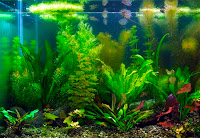Thursday, October 17, 2013
Koi Herpes Virus
Koi Herpesvirus (KHV) is a very damaging and easily spread virus that affects common carp and carp varieties such as koi Fish. Koi Herpesvirus (KHV) represents a third cyprinid herpesvirus formally designated Cyprinid herpesvirus 3(CyHV-3). Other nomenclature (Carp Interstitial Nephritis and Gill Necrosis Virus (CNGV)) has been suggested. Koi Herpes Virus is not new. It has been around for decades, even before we knew what it was. Koi were said to have a sleeping disease or some other explanation.
Outbreaks of the disease occur in summer, when water temperatures are high, and can kill between 20% and 100% of carp in a fishery. The disease is most likely to be spread when fish are stocked. But it is also possible that the virus could be moved on fishing tackle. To protect your fishery, or the place you fish, there are practical steps you can take.
If your fishery has an outbreak of the disease, there are also actions you can take to reduce the losses and ensure that the fishery can recover as quickly as possible. You can also take action to prevent problems in the future.
The virus will spread from one koi to the next only when the infected koi is “shedding” the virus. By shedding I mean producing and releasing the virus from its body. It is possible for an infected koi to not be shedding the virus and not spread it to another koi. It is also possible for a koi to have briefly come in contact with the virus, develop antibodies to the virus, but never contract the virus. This is why 100% accurate testing is difficult to achieve.
No KHV quarantine or testing procedure offers 100% assurance a koi previously infected with KHV will be detected. Through quarantine and serological testing we can greatly reduce the odds of infecting other koi. Serological technology is available to measure antibodies to the KHV virus. Both Enzyme Linked Immunosorbant Assay (ELISA) and the Virus Neutralization Antibody Assay (VN) serologies are available at modest cost, the latter being the most sensitive. The KHV disease outbreak illustrated in the photos should have been prevented by testing the fish for the carrier state while in quarantine.
Serology done on survivors strongly suggests some imports had survived a previous KHV infection as they carried low antibody titers. It is unclear how long a KHV survivor will maintain detectable antibodies but studies are in progress. The CEFAS group has demonstrated detectable antibodies a year or more following infection. Using serology on fish in quarantine is another tool we have available for protecting our collections.
If a fish has detectable levels of antibodies to KHV, it has been previously infected and must be considered a carrier. Carriers have the potential to shed the virus at a later time, infecting other fish. Materials and procedures we find useful for drawing blood for anti KHV antibody testing are outlined.
Source:
http://www.simikoi.com/subcat421.html
http://www.koihealth.org/
Labels:
Koi Care,
Koi diseases
Subscribe to:
Post Comments (Atom)
Total Pageviews
Labels
KOI POND
Koi Pond Filter
Koi Fish
Koi Care
Koi Type
Koi Clasification
POND FILTER
Koi Equipment
NISHIKIGOI
POND WATER
Kohaku
Aeration Koi Pond
KOI COLOR
Building a koi pond
KOI FOOD
KOI GROWTH
Koi Classification
Koi Pond Design
Koi diseases
Pond Equipment
SANKE
KOI PATERN
Pond Filtration
SHOWA
GOSANKE
Koi Pond Water
Koi Ponds
Koi Treatment
Cheap Koi Pond Filter
DIY Pond Filter
FEEDING KOI
Garden Pond
Goldfish Diseases
Koi Breeding
Koi keeping
OGON
Selecting Koi
Water Pump
Aquatic Plant
BEKKO
BUDO GOROMO
Filter Media
Fish Pond
Fresh Water
Green Water In Koi Pond
KAWARIMONO
Koi Health
Koi Spawning
Koi diet
Koi varieties
Pond Construction
SHOW KOI
Selecting Koi Fish
Veggie Filter
Water Filtration
Water Garden
color enhancing koi foods
water filter
ASAGI
Aeration System
Air Diffuser Aerator
Air pump
Algae Booming
Algae control
Anchor Worm Diseases
Aquatic Pond
Argulus
Asagi Koi
BENIGOI
Backyard Pond
Bakki Shower
Bakki Shower Filter
Best Koi Fish
Bio filter
Biological Filtration
Bog Filter
Bonsai Plant
Bonsai Tree Care
Breeding Koi
Buble diffuser
Building Koi Pond
CHAGOI
CHAMPION KOI
Choosing Koi
Choosing Pond Skimmer
Cleaning A Pond
Clearing Koi Pond Water
Control Algae
Culling Koi
Dechlorinator
Diferent of Male and Female Koi
Doitsu Koi
Filter Chamber
Filter Design
Filter For Small Pond
Floating Plant
Freshwater
GOROMO
German Carp
Ginrin Koi
Goldfish
Goldfish Pond Filtration
Good Koi
Goshiki
Gravity Pond Filter
Gravity Shower Filter
HAIJIRO
HIKARIMONO
HIKARIMOYO
Hikari Mono
Home Made Koi Food
Home Made Pond Filter
How To Build Koi Pond
Ideal Koi Pond
Japan Koi
Japan Koi Show
KARASUGOI
KIGOI
KOI BOOK
KOI FORM
KUMONRYU
Kin Ginrin Koi
Koi
Koi Breeder
Koi Farm
Koi Fish Food
Koi Hobby
Koi Injection
Koi Pattern
Koi Pon Filter
Koi Pond Building
Koi Pond Contruction
Koi Pond Filtration Design
Koi Pond Shape
Koi Quarantine
Koi Show
Koi Stress
Koi evelopment
Koi parasites
Koi tatoos
Landscaping
MATSUBA
Make Koi Body shape
Momotaro Filter
Multichamber Filter
Natural Filter
Nishikigoi breeding
OCHIBA
Ornamental Fish
Overflow system
Oxygenators Water Plant
Pine Core Diseases
Pond Filter Construction
Pond Filter Function
Pond Filters
Pond Lighting
Pond Liner
Pond Liners
Pond Maintenance
Pond Planing
Pond Requirement
Pond Skimmer
Pond aerator
Ponds Plant
Red White Koi
Roto Pond Filter
SORAGOI
Sand Filter
Selecting Asagi Koi
Sexing Koi
Shiro Bekko
Simple Pond Design
TANCHO
Tategoi
Treat Dropsy
Trickle Filter
UTSURIMONO
UV Sterilization
VORTEX CHAMBER
Vegetable Filter
Water Garden Filtration
Water Heater
Water Plant
Water Purifier
Water Quality Parameter
Water treatments
backyard waterfall
barley straw
caring for fish
chromataphores
cleaning pond
determining the quality Koi
garden waterfall
increases dissolved oxygen
koi carp
koi fish breeding
koi fish symbolize
make good koi color
natural biofilter
plant filter
pond design
showa high quality koi care
showa high quality koi information
showa koi fish meaning
waterfall function
waterfall pond





0 comments:
Post a Comment